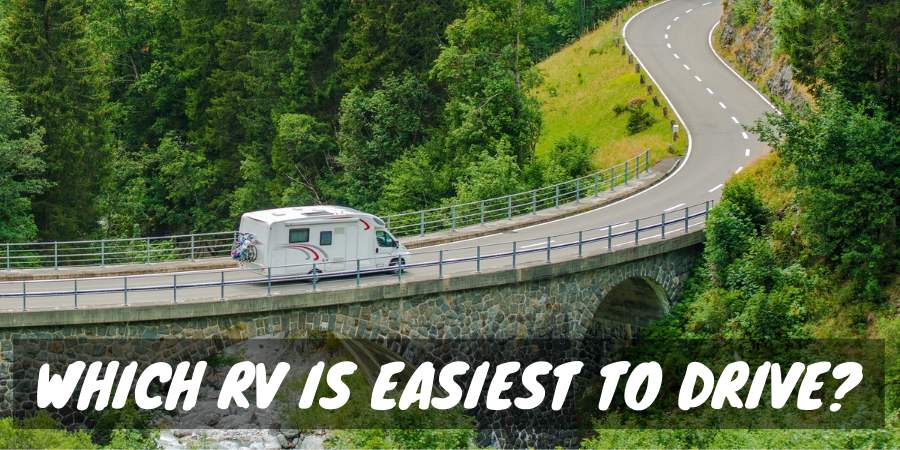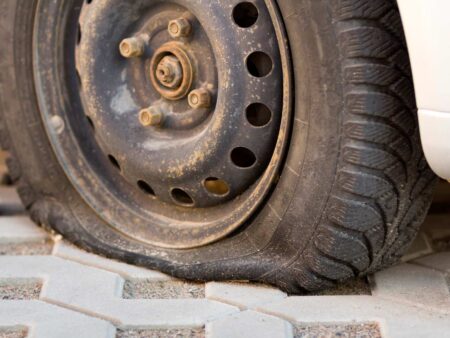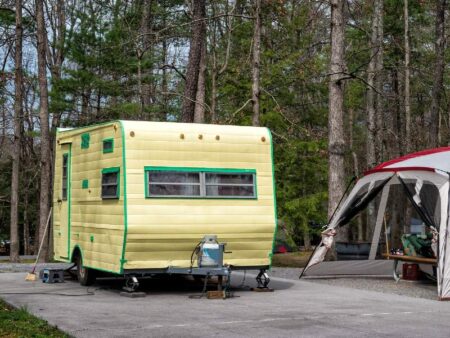Do you want an RV but are unsure how easy they are to drive or pull with a truck? Many people are often curious about which RV is the easiest to drive. It can be quite beneficial to familiarize yourself with the top brands and models renowned for their driveability.
Down below, you’ll find all the information you need on RVs that are easy to drive and which travel trailers provide the most towing safety and stability.
So keep reading to learn what features increase RV driveability and which specific RV types and models users agree are the best and least stressful to drive.
What Improves RV Driving By Type
There is a combination of factors that make driving an RV easier. For you to purchase the best RV for driving, you need to look at how each type affects driving ease.
RV TYPE
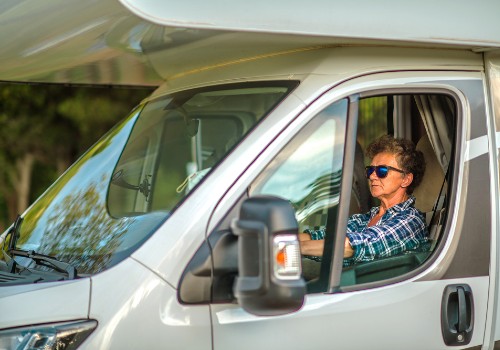
If your first concern is driveability over any other RV features, you need to know the different types of RVs available and their overall road handling.
There is a difference between the ease of driving an RV with plenty of power and control and one that is lacking. There is also knowing how easy or uneasy you may feel driving a very long RV or towing a camper.
A short test drive at a dealership or with a private sale is not going to give you an honest understanding of long-term driving comfort and safety.
TIP: If your test drive feels unsafe because braking time seems slow or the rig feels wobbly, take a pass. If not, when you get home and load the hundreds (if not thousands) of pounds of supplies into the camper it will only perform worse.
Class A Motorhome or Motorcoach
Class A RVs look like buses with large, flat front ends.
RVers typically refer to shorter models as motorhomes, while models over 35 feet in length are “motorcoaches,” but technically, the names are interchangeable.
The benefits of Class A RVs that increase ease of driving include:
- Expansive windshield for the best visibility
- Large, comfortable driver’s seat
- Dashboard displays are more accessible and easy to read
- Front-end shape decreases wind noise
- Durable bus-style chassis and engine that is more stable and powerful on the road
Class B Motorhome
A Class B motorhome or campervan is a stock cargo van chassis customized into an RV. The length of Class B RVs tops out around 24 feet.
The benefits of Class B RVs that increase ease of driving include:
- Smaller size and width increase maneuverability on and off highways
- Less weight means you can slow down or stop the camper faster in emergency situations
- A slimmer profile reduces the impact of wind
- The driver-cab area is similar to a car, and the large windshield increases the visibility
- Better fuel mileage means fewer stops during trips
Class C Motorhome
Class C motorhomes are built on a pickup truck chassis and feature an over-the-cab structure that typically holds a bed or storage. Class C RVs are under 40 feet in length, with most in the 20 to 34-foot range.
The benefits of Class C RVs that increase ease of driving include:
- Wide truck chassis increases stability during driving maneuvers
- Cab area features controls much like a car, which feels more “natural”
- Shorter length and weight reduce wind drag
- Many have dually back tires that increase safety and stopping speeds
- The beefy engine provides plenty of power
Fifth-Wheel
Fifth wheels are towable travel trailers that use a hitch to connect to the bed of a 4×4 truck, much like those on semi-trucks. A 250HP or larger truck is the norm for safe fifth-wheel transport of units 28 feet or longer.
The benefits of Fifth-Wheel RVs that increase ease of driving (and towing) include:
- The hitch design centers the camper weight forward and between the truck axles, which increases stability
- You are towing with a truck that has familiar controls and a familiar feel
- Less sway of the trailer while driving from wind or quick lane changes
- Some states allow passengers to travel inside a fifth-wheel RV while driving
Travel Trailer
Travel trailer campers can be of any size, from an 8-foot-long teardrop to a 33-foot Airstream. The pull-behind trailer is attached via a hitch to the back of a truck or SUV.
The benefits of Travel Trailer RVs that increase ease of driving (and towing) include:
- Units are more lightweight and, therefore, put less strain on your tow vehicle
- Lower profile decreases frontal drag at highway speeds
- Many can be pulled by a smaller truck or SUV, which are easier to maneuver
Which RV Is Easiest to Drive?
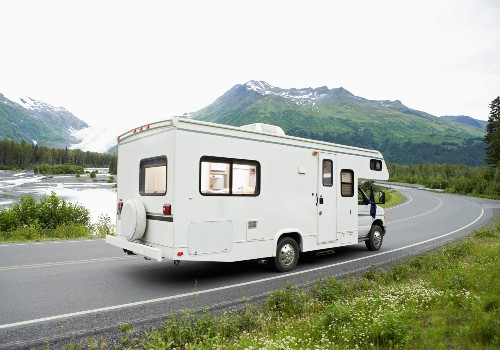
The Class B RV is the easiest to drive overall. The feeling is very much the same as driving a large SUV or van.
While small Class C RVs come in a close second for easy driveability, the Class B campervans allow owners to:
- Fit just about anywhere
A Class B recreational vehicle is only seven feet wide (a good 12-inches skinner than other RVs), which means it glides easily down roadway lanes without the need to constantly monitor your lane position.
The height of a Class B is also shorter, which means you won’t be sucking in your breath when you suddenly come upon a low-clearance underpass or low-hanging branches.
The length of Class Bs also fits well within the confines of two standard parking spaces, which not only works well for shopping centers but even for parking along city streets.
Getting in and out of drive-thru restaurants and gas stations is also a breeze in a Class B, which is challenging, if not impossible, in other types of RVs.
Getting to more remote camping locations is also easier in a smaller Class B, as it fits down narrower roads, can make sharper turns, and has a strong enough engine and build to power over rougher terrain.
Fuel-Efficient
A Class B is easier to drive because it’s easier on your wallet when it comes to fuel expenses.
While the vehicle gets less gas mileage than a car, many Class B motorhomes have twice the fuel efficiency of other RV types. Towable RVs typically rely on fuel-hog trucks to pull the camper, which increases fuel costs over a Class B.
Better Handling
It’s easier to drive a Class B because the handling is much more like an SUV and not like a cargo truck or bus.
The mirrors allow you to see the back corners of the RV, which makes backing up or turning around much easier.
The wind is an RVer’s nightmare. Not only does it lower your already poor gas mileage, but it can quite literally blow you all over the road. The lower, more streamlined profile of a Class B RV handles wind issues much more efficiently and safely than other taller, longer, and more boxy RV styles.
License and Maintenance Needs
Want to Connect With a Community of Over 1,078 RV Enthusiasts?
Unlike a Class A motorcoach, a Class B does not require a special license to drive in any state.
Maintenance on a Class B is also easier, as the engines are straightforward for any mechanic without RV experience to fix. Tires are of a standard size that just about any tire shop will have in stock.
Interiors of Class Bs tend to have fewer appliances or furniture that can break, which also reduces overall maintenance costs.
So Why Aren’t Class B Motorhomes the Only RVs on the Road?

For all the ease of driving a Class B, you are trading interior space and amenities for the ability to own an easy-to-drive RV.
The space inside a Class B is best for one or two people to travel in comfort. Many models do not have a toilet or shower, and storage space is also limited.
For people who want to enjoy their destination with the comforts of home, the additional space larger RVs provide is worth the trade of a more stressful driving experience.
Best RV Brands for Easy Drives
CLASS B – Leisure Travel Vans get exceptional ratings from customers for the smoothness and quietness of the ride, great gas mileage, quick response and handling, sharp styling, and interior design features.
CLASS A – The Entegra Aspire gets top marks from owners who rave about the great gas mileage, strong horsepower to manage inclines or towing a toad, and a cushy ride with few bumps or vibrations.
CLASS C – The Jayco Greyhawk 31FS is a favorite Class C RV for its powerful engine, good insulation that reduces road noise, and comfortable cockpit and controls that make you almost forget you are pulling along a house on wheels.
FIFTH WHEEL – The Keystone Laredo gets recognition for the ease of hook-up and towing stability in even poor weather conditions. Of course, the right truck is imperative to overall good handling.
TRAVEL TRAILER – The Grand Design Imagine XLS gets good marks for easy towing because it controls problematic braking or swaying common in travel trailers. The integrated backup assist system is another bonus that lessens driving stress.
Conclusion
Class B RVs are the easiest to drive, but all RVs are manageable when you have the right training, practice, and equipment.
Remember that RVing is about more than just comfort and ease while driving. You want your adventures to include room to spread out, space to carry your gear, and the ability to explore new areas once you reach your campsite.
When you can find the floorplan you love in an RV that is easy to drive, you have hit the RV jackpot.
How to Drive a Motorhome or RV (Video)
"Man cannot discover new oceans unless he has the courage to lose sight of the shore."
-- Andre Gide

